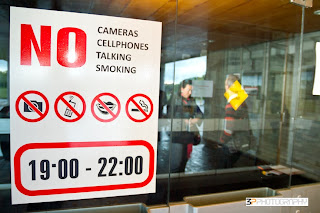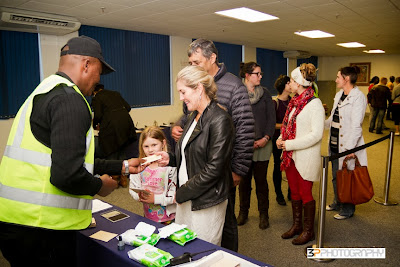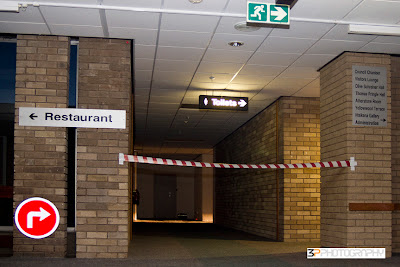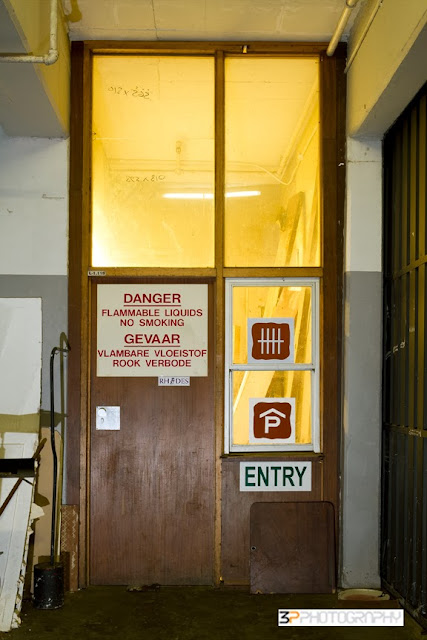I have written before about trying to synthesis the artistic creative endeavor wrapped up with everything that is photography, with maintaining the 'authenticity' of photographing a fine art exhibition. This was driven home once again, or the difficulty of the achieving this, when I was tasked with photographing Simone Heymans' MFA submission, titled "
via" a few weeks ago.
via was
a phenomenological site-specific series of
intermedia interventions and installations that centered upon our relationships to place primarily, but also space. What this means is that the location, in this case the many corridors and passageways of the 1820 Settler's Monument in Grahamstown, is significant and threaded into the meaning and comprehension of the experience. These sorts of exhibitions cannot simply be called viewings but are experiential and multifaceted in ways that traditional gallery spaces cannot begin to compete.
 |
| Entrance to via. Canon EOS 7D, Tamron SP 70-200mm at 70mm. ISO 200. f/11@8sec. Light painted with a handheld torch. |
Somehow, along the journey that is via, the offering begins to open up and question our understandings of place and
consumerism in a contemporary context of globalisation. It is not at all concerned with consumerism of goods like food and possessions, but is rather more concerned with media, conformity and management. Central
to the interventions that form the backbone of via are
theories of place
and non-place, especially Marc Augѐ (1995). According to him, “If a place can be defined as relational,
historical and concerned with identity, then a space which cannot be defined as
relational, historical, or concerned with identity will be a non-place”. As Simone Heymans' supervisor says, "Non-places are therefore those habitually
transient, paradoxically fast-paced yet motionless, waiting spaces that one
frequents daily. They are spaces of consumerism, circulation and consumption.
They are simultaneously a symptom of globalisation and the three excesses of
Supermodernity, namely, excess of the ego, space and time.
 |
| via begins with a queue to register and complete documentation. Canon EOS 7D, Sigma 18-50mm at 31mm. ISO 200. f/2.8@1/20th. Fill flash. |
 |
| Canon EOS 7D, Sigma 18-50mm at 18mm. ISO 200. f/2.8 @ 1/20th. Fill flash, bounced at 1/2th power. |
 |
| Registeration consists of fingerprinting, legal documentation and identification documents. Canon EOS 7D, Sigma 18-50mm at 31mm. ISO 200. f/2.8@1/20th. Fill flash. |
 |
| Canon EOS 7D, Sigma 18-50mm at 18mm. ISO 200. f/2.8@1/20th. Fill flash. |
So how does one even attempt to try and capture some of this in the images that will be used as documents of evidence for the exhibition? How does one record these elements when photographing/recording/capturing the event/experience? This is the conceptual concern and has little to do with the technical aspect. Yet.
The short answer is: with difficulty. via explores and disrupts the superficially tight definition of a non place by means of an organised walkabout where
participants are invited to consider their own perceptions and ingrained social
codes that evolve within these spaces. The experience was strictly controlled (by hired security guards) who managed queues, ordered and organised people into groups and escorted them to the various sections at specific times and intervals. Carefully placed interventions (the equivalent of 'artworks' I suppose, though they don't pretend to be) are blended into existing signage and indicators, or 'modes of management and organisation'. So it is tour-like but with an ominous and constant presence of authority and surveylance and control.
 |
| Canon EOS 7D, Sigma 18-50mm at 40mm. ISO 1600. f/2.8@1/8th. |
 |
| Canon EOS 7D, Sigma 18-50mm at 23mm. ISO 800. f/2.8@1/30th. Fill flash at 1/8th power. |
 |
| Canon EOS 7D, Sigma 18-50mm at 18mm. ISO 400. f/2.8@1/6th. Fill flash at 1/8th power. |
 |
| Canon EOS 7D, Sigma 18-50mm at 23mm. ISO 800. f/3.5 @ 1/30th. Fill flash at 1/16th power. |
 |
| Canon EOS 7D, Sigma 18-50mm at 24mm. ISO 800. f/2.8 @ 1/30th. Fill flash at 1/16th power. |
 |
| Canon EOS 7D, Sigma 18-50mm at 23mm. ISO 400. f/3.5 @ 1/45th. Fill flash, bounced at 1/16th power. |
|
 |
| Canon EOS 7D, Sigma 18-50mm at 18mm. ISO 200. f/2.8 @ 1/8th. Fill flash, bounced at 1/8th power. |
 |
| Canon EOS 7D, Sigma 18-50mm at 35mm. ISO 400. f/3.5 @ 1/90th. Fill flash, bounced at 1/4th power. |
 |
| Canon EOS 7D, Sigma 18-50mm at 26mm. ISO 200. f/2.8 @ 30sec. Bounced flash, handheld with 2x firings at 1/2 power. |
Back to the photographing.... So couple the conceptual problem as outlined above with the very real limitations of space (or non space :) ), this time in a photographic sense and then add ... yep, you guessed it, bad light (again photographically speaking) and there is thus presented a very real challenge. What a pleasure!
 |
| Canon EOS 7D, Sigma 18-50mm at 21mm. ISO 800. f/2.8 @ 1/30th. Fill flash at 1/4 power. |
 |
| Photographic stitch using PS of three images. Canon EOS 7D, Sigma 18-50mm at 32mm. ISO 400. f/8 @ 30sec. Light painted with hand held torch |
















